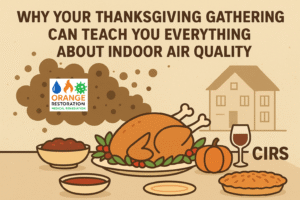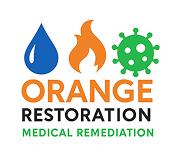Thanksgiving is supposed to be about food, family, and warmth, not about small particle issues or air quality.
Yet it’s one of the few times of the year when every factor that affects indoor air happens all at once: the HVAC running nonstop, the oven on for hours, the doors opening and closing all day, pets and people tracking in outdoor Fall debris, and a house full of stirring, breathing, talking guests.
It’s the one holiday that accidentally becomes a real-life demonstration of how small particles move through a home, and how they impact people differently.
READ MORE: Ultrafine Particulate Matter Removal
The Invisible Dust No One Thinks About
Everyone wipes the counters before setting out the appetizers. We clean the visible stuff, crumbs, fingerprints, splatters… the easy targets.
But the REAL dust?
The stuff you can’t see?
Ultrafine small particles from cooking oils, HVAC systems, pets, fibers, mold fragments, and normal human activity?
Those are the small particles, they are small enough to stay airborne, bypass the body’s defenses, and land deep in the lungs.
They ride the air currents created by:
- Open oven doors
- Stovetop heat plumes
- People walking around
- The furnace cycling on and off
And because Thanksgiving is usually a “shut the windows, turn on the heater” day, the home becomes a sealed container where these particles accumulate.
For most people, it’s just a normal holiday.
For sensitive individuals, CIRS patients for example, it’s a physiological landmine.
Why Someone Always Sneezes When the Heater Kicks On
Every family has that one person who sneezes as soon as the heater blows its first warm gust of air.
We brush it off as “dust,” but the explanation is more interesting, and more scientific.
When HVAC systems sit dormant for long periods, particles settle inside the ductwork:
- Mold fragments
- Pet dander
- Insulation fibers
- Bacteria
- Combustion particles
- Household dust
- Cooking residue
The moment the system fires back up for the season, all that material gets aerosolized and pushed straight into the living areas.
A dormant HVAC system is basically a small particle reservoir waiting for ignition to be sent into the air. .
For someone with CIRS or MCAS, that burst of particles isn’t just irritating, it can activate their immune system, trigger inflammation, disrupt breathing, and cause a crash within minutes to hours.
It might not be tryptophan that causes the crash after turkey for some.
READ MORE: Learning About CIRS, Your Health & Home

Cooking Aerosols: The Thanksgiving Fog You Don’t See
Thanksgiving cooking is basically an indoor air pollution festival, we just romanticize it because it smells good.
Frying, roasting, baking, simmering all release ultrafine small particles and VOCs that stay airborne longer than most people realize.
These particles:
- stick to clothing
- migrate to bedrooms
- embed in upholstery
- get pulled into returns
- recirculate through the HVAC system
This is why air quality readings spike on holidays where heavy cooking happens. It’s also why sensitive individuals often feel worse before they ever walk into a “moldy” room: their system is already inflamed from airborne cooking byproducts.
Doors Opening, People Moving, Pets Roaming: All Stir the Air
Every footstep creates a micro-burst that stirs settled particles back into circulation.
Every coat thrown onto a bed carries fibers and outdoor contaminants.
Every dog brushing by the couch creates a little plume of dander.
Thanksgiving = particle movement.
You don’t see it, but your lungs register it.
Why CIRS Patients Struggle at Holiday Gatherings
Most families interpret a reaction like this:
- Sudden fatigue
- Throat tightness
- Dizziness
- Brain fog
- Sinus pressure
- Irritability
as stress, social anxiety, or “holiday overwhelm.”
But CIRS patients often react because:
- the HVAC system is blowing out microbial fragments
- cooking aerosols are saturating the air
- the home has an undiagnosed water-damage history
- the ventilation rate is too low
- small particles accumulate from normal activity
It’s not emotional dysregulation, it’s particle exposure.
Visiting relatives during the holidays is one of the leading trigger events for CIRS crashes.
Patients often think they’re “reacting to family,” but it’s usually the building.
Why This Matters (And Why It’s Not About Fear)
The goal isn’t to make people scared of Thanksgiving.
It’s to help people understand how building science intersects with health, and why medically sound remediation isn’t overkill, it’s necessary.
Think in terms of Empathy: clean before you invite a huge group in your home, work to make safe spaces for the sensitive, and listen to them, they are not trying to be a downer, but to desperately join the family.
Thanksgiving teaches us that:
- indoor air is dynamic
- particle behavior matters
- HVAC maintenance is health care
- ventilation isn’t optional
- sensitive individuals aren’t dramatic, they’re physiologically reacting
This is where medically sound remediation stands apart:
It accounts for small particles, HVAC pathways, moisture history, and human physiology, not just surface mold or visible dust.
Special Thank you to CIRS Warriors, CIRS Professionals, and Families of CIRS patients
As we head into Thanksgiving, we’re reminded that healing, especially for those living with CIRS, is never a solo journey. It takes a village of families, clinicians, coaches, environmentally conscious professionals, and compassionate friends and family who choose understanding over judgment.
This season, we want to extend our deepest gratitude to the families who have trusted us inside their homes, often during some of the most vulnerable chapters of their lives. You’ve invited us not just to clean a space, but to help restore a sense of safety, calm, and belonging in the very air you breathe.
We are equally grateful to the CIRSx community and the dedicated professionals who continue to advance medically sound remediation protocols. Your commitment to science-based solutions has allowed countless families to understand what invisible contaminants, especially small mold particles, can do to their health, and more importantly, what they can do to reclaim it.
Small particle remediation isn’t just a service; it is an act of restoring dignity and possibility to those who have been dismissed, misunderstood, or told their symptoms were “in their heads.” We are working as humanitarian pioneers in science to justify a wrong some still do not fully understand.
To Dr. Shoemaker and all Shoemaker Protocol coaches: thank you for giving clarity where confusion once lived, and for giving patients a map out of suffering that often went overlooked for years. Your work has changed lives, and every step forward we take in remediation reflects the foundation you built.
And finally, a heartfelt thank-you to the spouses, children, parents, and friends of CIRS patients, the people who decided empathy was more powerful than doubt, who showed up when it would have been easier to walk away.
Healing thrives in homes where compassion circulates just as intentionally as clean, particle-free air.
This Thanksgiving, our gratitude is for you. For your resilience, your trust, and your belief that healthier homes lead to healthier futures. We’re honored to walk this path of healing humanity, one family, one home, one small particle at a time.
